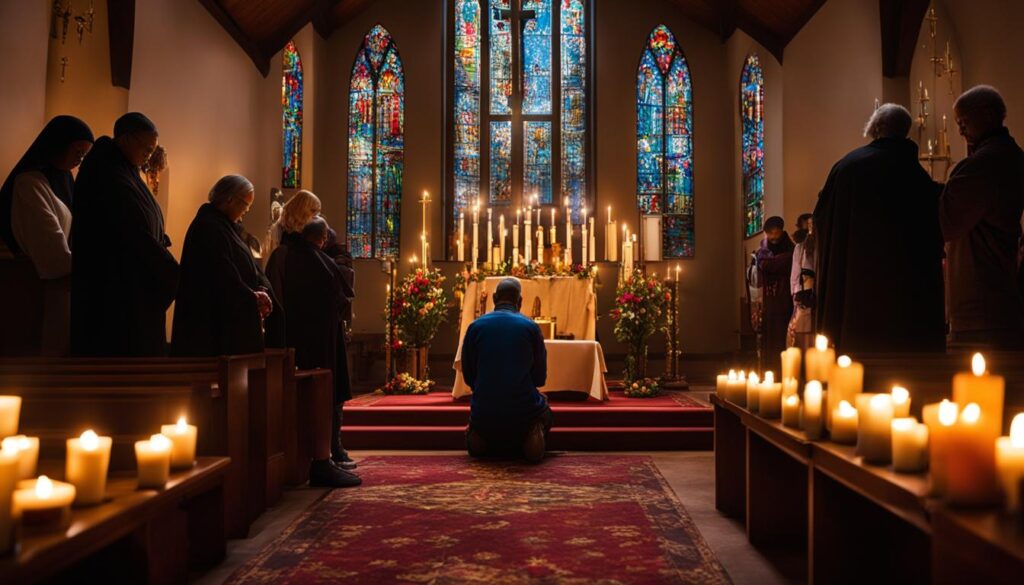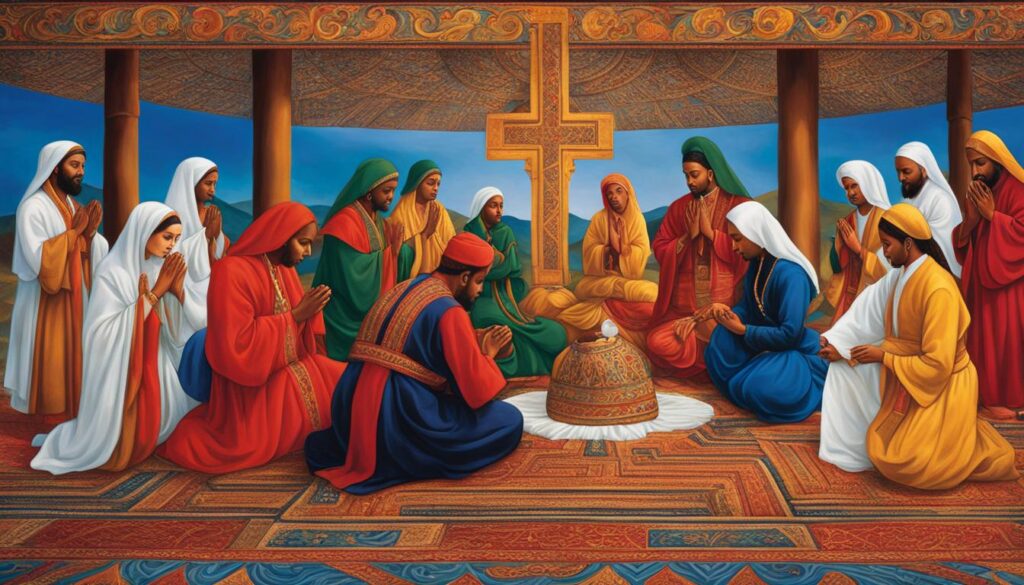Catholic prayers have been a vital part of the Catholic tradition for over 2000 years. They provide a way for individuals to connect with God and deepen their faith. There are a wide variety of prayers available, from the Our Father and the Rosary to lesser-known prayers such as the Anima Christi. These prayers can be found in traditional Catholic prayer books and are also readily available online. They serve as a source of comfort, guidance, and spiritual growth for Catholics around the world.
Key Takeaways:
- Prayer is an integral part of the Catholic tradition, fostering a deeper connection with God.
- There is a wide range of traditional Catholic prayers, including well-known classics like the Our Father and the Rosary.
- Lesser-known prayers like the Anima Christi offer unique opportunities for spiritual growth.
- Traditional Catholic prayer books and online resources provide easy access to a variety of prayers.
- Catholic prayers offer comfort, guidance, and a means of deepening one’s faith.
The Power of Catholic Prayers in Times of Turmoil
In times of turmoil and uncertainty, Catholic prayers can provide a sense of peace and solace. These prayers have been passed down through generations and hold immense spiritual significance for believers. They offer a way to seek God’s guidance, protection, and grace during difficult times.
One powerful prayer is the Five First Saturdays devotion, which involves attending Mass, receiving Holy Communion, praying the Rosary, and meditating on the mysteries of the Rosary for five consecutive first Saturdays of the month. This devotion aims to console the Immaculate Heart of Mary and seek her intercession for the world. By participating in this devotion, Catholics can find comfort and strength.
Another prayer that holds great significance is the Saint Michael Prayer. This prayer seeks the intercession of Saint Michael the Archangel, known as the protector of the Church and the guardian against evil. By invoking his protection, Catholics can find courage and spiritual strength to overcome challenging situations. The Rosary, a prayer consisting of repetitive sequences of prayers and meditation on the life of Jesus and Mary, is also a powerful tool in times of turmoil. It provides a sense of calm and enables individuals to find solace in their faith.
“Prayer is not asking. It is a longing of the soul. It is the daily admission of one’s weakness. It is better in prayer to have a heart without words than words without a heart.” – Mahatma Gandhi
Furthermore, November holds special significance for Catholics as it is the month dedicated to praying for the holy souls in purgatory. During this time, Catholics offer prayers, Masses, and acts of penance for the souls who have departed and are undergoing purification. This practice provides a way to remember and honor loved ones who have passed away and seek God’s mercy for them.
| Prayer | Description |
|---|---|
| Five First Saturdays Devotion | A devotion that involves attending Mass, receiving Holy Communion, praying the Rosary, and meditating on the mysteries of the Rosary for five consecutive first Saturdays of the month. |
| Saint Michael Prayer | A prayer that seeks the intercession of Saint Michael the Archangel, known as the protector of the Church and the guardian against evil. |
| Rosary | A prayer consisting of repetitive sequences of prayers and meditation on the life of Jesus and Mary. |
During times of turmoil, it is essential to turn to Catholic prayer resources and traditional devotions to find solace, strength, and guidance. These practices have withstood the test of time and have provided comfort to countless individuals throughout history. By embracing the power of Catholic prayers, believers can navigate the challenges of life with a sense of peace and trust in God’s love and care.
Growing in Grace through Catholic Prayer
The Catholic tradition offers a rich array of liturgical prayers, traditional devotions, and resources that enable individuals to deepen their relationship with God and experience His grace. These prayer practices serve as tools for spiritual growth, providing opportunities for Catholics to express their love and devotion to God. By engaging in prayer, Catholics can receive joy, strength, and consolation, allowing them to live in union with God.
One crucial aspect of growing in grace through Catholic prayer is the use of liturgical prayers. These prayers are an integral part of Catholic worship, providing a structured and communal approach to prayer. Liturgical prayers, such as the Mass, offer a way to participate in the Church’s rich tradition and connect with the larger Catholic community. By actively engaging in liturgical prayers, individuals can deepen their understanding of the faith and experience a sense of unity with fellow believers.
In addition to liturgical prayers, traditional devotions are also essential in nurturing one’s prayer life. Devotions like the Stations of the Cross, the Divine Mercy Chaplet, and the Novena to the Sacred Heart of Jesus provide Catholics with specific prayers and reflections that focus on particular aspects of their faith. These devotions help individuals meditate on the life of Christ, seek intercession from saints, and cultivate a more profound spiritual connection with God. They offer a way to express personal intentions and receive guidance and support in their spiritual journey.
To illustrate the power of traditional devotions, here’s a table comparing a few popular devotions and their unique characteristics:
| Devotion | Description | Key Benefits |
|---|---|---|
| The Rosary | A prayer that focuses on the life of Jesus and the Virgin Mary. Consists of the repetition of prayers and meditation on the mysteries of Christ. | Brings peace, fosters contemplation, and deepens one’s relationship with Jesus and Mary. |
| The Divine Mercy Chaplet | A prayer that emphasizes God’s mercy and asks for His forgiveness for oneself and the whole world. Comprises the repetition of specific prayers and the contemplation of Jesus’ passion and death. | Offers a powerful plea for mercy, strengthens trust in God, and promotes forgiveness and compassion. |
| The Stations of the Cross | A devotion that allows individuals to reflect on Jesus’ journey to Calvary. Involves meditating on the events leading to His crucifixion and death. | Deepens understanding of Christ’s sacrifice, inspires gratitude, and encourages personal reflection and transformation. |
These devotions, along with many others, provide Catholics with a framework to grow in grace and experience God’s presence more deeply. By incorporating liturgical prayers and traditional devotions into their prayer life, individuals can cultivate a vibrant and meaningful spiritual journey, drawing closer to God and embracing His grace in their daily lives.

Overcoming Distractions and Nurturing Prayer Life
In today’s fast-paced world, distractions can often hinder our prayer life and make it challenging to maintain a consistent and meaningful connection with God. However, there are ways to overcome these distractions and nurture our prayer life.
Saint Pio of Pietrelcina, known as Padre Pio, once said, “Pray, hope, and don’t worry.” These words remind us that distractions are a normal part of prayer and that we should not let them discourage us. Instead, we can acknowledge their presence and take steps to manage them. One effective approach is to create a peaceful and dedicated space for prayer. This can be a quiet corner in our home, a church, or a serene outdoor setting where we can retreat from the noise and busyness of everyday life.
“Pray, hope, and don’t worry.” – Padre Pio
Traditional Catholic prayer books can also be valuable resources in overcoming distractions. These books provide a wealth of prayers, meditations, and reflections that can guide us in our prayer journey. They offer structure and guidance, helping us stay focused on our conversation with God. Additionally, practicing specific Catholic prayer rituals, such as lighting candles or using prayer beads, can help us engage our senses and create a deeper sense of reverence and connection during prayer.
Table: Tips for Overcoming Distractions in Prayer
| Tips | Description |
|---|---|
| Minimize external distractions | Create a quiet and dedicated space for prayer, free from technological devices and other distractions. |
| Set a specific time for prayer | Establish a regular prayer routine, whether it’s in the morning, evening, or during a specific part of the day. |
| Use prayer aids | Utilize traditional Catholic prayer books, devotional materials, or apps that provide guided prayers and reflections. |
| Practice mindfulness | Learn techniques such as deep breathing and grounding exercises to help quiet the mind and increase focus during prayer. |
| Embrace silence | Allow moments of silence in prayer to listen for God’s voice and reflect on His presence. |
By implementing these strategies and utilizing the resources available to us, we can overcome distractions and nurture a more vibrant and consistent prayer life. It is through this dedicated practice of prayer that we can deepen our relationship with God and experience His love, guidance, and transformative grace.
Prayer as a Response to God – Building a Relationship
Prayer is not just a one-way conversation; it is a response to God’s invitation for a deeper relationship. Catholics believe that God always initiates the conversation, and praying is their way of responding to Him. Prayer should be seen as a relational experience, similar to having a conversation with a friend. It requires honesty, openness, and consistency. By actively engaging in prayer practices and rituals, individuals can build a closer relationship with God and experience His love and guidance.
One way to cultivate this relationship is through the various Catholic prayer practices and rituals. These practices serve as a framework for regular communication with God and help individuals stay connected to their faith. Whether it’s reciting the Liturgy of Hours, participating in the Stations of the Cross, or attending Mass, each practice offers a unique opportunity to encounter God and deepen one’s understanding of the Catholic tradition.
Prayer is not asking. It is a longing of the soul. It is daily admission of one’s weakness. It is better in prayer to have a heart without words than words without a heart. – Mahatma Gandhi
The Importance of Consistency
Consistency is vital in any relationship, and the same applies to our relationship with God through prayer. By setting aside dedicated time each day for prayer, individuals can create a habit of regular communication with God. This consistency allows for a deeper connection to form and fosters spiritual growth. Whether it’s a few minutes of silent reflection, reciting traditional prayers, or engaging in personal conversations with God, the act of consistent prayer helps strengthen the bond between the individual and their Creator.
Prayer is a powerful tool for building a relationship with God. It allows individuals to open their hearts, express their gratitude, seek guidance, and find solace in times of need. By embracing Catholic prayer practices and rituals, individuals can embark on a transformative journey of faith, deepening their relationship with God and experiencing His presence in their lives.
Exploring Different Forms of Catholic Prayer
The Catholic tradition offers a wide range of prayer forms to suit different needs and preferences. From daily prayers such as the Our Father and the Rosary to special prayers like the Anima Christi, Catholics have a variety of prayer options to choose from. These prayer forms have been passed down through generations and hold deep spiritual significance for believers. They provide a means of connecting with God, expressing gratitude, seeking guidance, and offering supplication.

Additionally, prayers associated with specific times in the liturgical year provide unique opportunities for individuals to deepen their spiritual connection during these holy seasons. For example, during Lent, Catholics engage in prayer practices such as the Stations of the Cross and the Chaplet of Divine Mercy, which reflect on Christ’s passion and sacrifice. Pentecost, on the other hand, is a time of fervent prayer and celebration of the Holy Spirit’s descent upon the apostles. These specialized prayers enhance the worship experience and foster a sense of communal devotion.
Table: Comparison of Different Forms of Catholic Prayer
| Prayer Form | Description | Purpose |
|---|---|---|
| The Our Father | A central prayer in Christianity, taught by Jesus himself | To seek God’s guidance and provision |
| The Rosary | A meditative prayer that focuses on the life, death, and resurrection of Jesus and the intercession of Mary | To honor Mary, seek her intercession, and meditate on the mysteries of faith |
| The Anima Christi | A prayer that dates back to the 14th century, expressing a desire for union with Christ | To deepen personal relationship with Christ and seek His healing and sanctifying grace |
| The Chaplet of Divine Mercy | A prayer that emphasizes the mercy of God and the power of Christ’s sacrifice | To seek God’s mercy, intercede for others, and meditate on the depth of His love |
Traditional Catholic prayer books serve as a valuable resource for exploring and learning about these different forms of prayer. They provide guidance on how to properly engage in each prayer, offer reflections and interpretations, and contain additional prayers and devotions. These books are an essential tool for Catholics seeking to deepen their prayer life and enhance their spiritual journey.
In summary, the Catholic tradition offers a rich tapestry of prayer forms that cater to the diverse needs and spiritual yearnings of believers. From ancient prayers passed down through generations to specialized prayers associated with specific liturgical seasons, Catholics have a wealth of options to explore. These prayer forms foster a deeper connection with God, provide comfort and solace, and serve as a means of expressing devotion and seeking divine guidance. By engaging in different forms of Catholic prayer, individuals can embark on a transformative journey of faith and experience the profound grace and love of God.
Overcoming Prayer Challenges and Embracing Grace
Despite the challenges that may arise in prayer, Catholics are encouraged to persevere and trust in God’s grace. Prayer can help individuals manage daily difficulties, resist temptations, and foster positive emotions such as humility, compassion, and forgiveness. Even in times of dryness or doubt, Catholics are reminded that God is always present and ready to provide the grace needed to weather the storms of life. By embracing prayer and allowing God to work through them, individuals can experience His love and share it with others.
One of the challenges Catholics may face in prayer is distractions. Distractions can easily disrupt the focus and flow of prayer, making it difficult to maintain a deep connection with God. However, it is important to remember that distractions are a normal part of the prayer experience. Saint Pio of Pietrelcina once said, “pray, hope, and don’t worry.” Acknowledging distractions and gently bringing the focus back to prayer can help individuals overcome these challenges and stay connected with God.
Catholics can also find guidance and support in traditional Catholic prayer books, liturgical practices, and rituals. These resources provide a structured framework for prayer, offering a roadmap for individuals to navigate their prayer journey. Traditional Catholic prayer books, in particular, can serve as a valuable tool for exploring different forms of prayer and deepening one’s understanding of the Catholic tradition. They contain a wealth of prayers, devotions, and rituals that can inspire and enrich the prayer life of Catholics.
In summary, despite the inevitable challenges that may arise in prayer, Catholics are encouraged to persevere and trust in God’s grace. By embracing prayer, managing distractions, and utilizing the resources available, individuals can overcome these challenges and experience a deeper connection with God. Prayer is not only a means of seeking comfort and guidance but also an opportunity to grow in humility, compassion, and forgiveness. Through prayer, Catholics can embrace God’s grace and share His love with others.
Conclusion
Prayer is an integral part of the Catholic tradition, offering a profound connection with God, a deepening of faith, and an experience of His abounding grace. Through traditional Catholic prayers, liturgical practices, and personal devotions, individuals can find solace, guidance, and strength in the face of turmoil and everyday challenges. It is through a consistent and dedicated prayer life that Catholics embark on a transformative journey of faith and spirituality, drawing closer to the divine presence.
Catholic prayers provide a rich tapestry of spiritual resources that have nourished believers for centuries. These prayers, steeped in tradition, form a vital link to the roots of the faith and offer profound encounters with the divine. Whether it is reciting the Our Father, contemplating the mysteries of the Rosary, or delving into lesser-known prayers like the Anima Christi, each prayer serves as a unique pathway to communion with God.
By cherishing and embracing the gift of grace bestowed by God, Catholics can experience profound spiritual growth and an ever-deepening relationship with the divine. Through prayer, they find comfort in times of distress, guidance in times of uncertainty, and strength in times of weakness. Catholic prayer practices, rituals, and the treasure trove of traditional prayer books provide the structure and inspiration needed to foster a consistent and meaningful prayer life.
FAQ
How long have Catholic prayers been a part of the Catholic tradition?
Catholic prayers have been a vital part of the Catholic tradition for over 2000 years.
Where can I find Catholic prayers?
Catholic prayers can be found in traditional Catholic prayer books and are also readily available online.
Are there specific prayers for challenging situations?
Yes, prayers such as the Five First Saturdays devotion, the Saint Michael Prayer, and the Rosary are powerful prayers that can help individuals cope with challenging situations.
Is there a special time for Catholics to pray for the holy souls in purgatory?
November is an important month for Catholics to pray for the holy souls in purgatory.
How can Catholic prayers help individuals grow in grace?
Catholic prayers allow individuals to receive joy, strength, and consolation, and the more one prays, the more they can experience God’s grace and live in union with Him.
How can distractions be overcome in prayer?
By acknowledging that distractions are a normal part of prayer, individuals can learn to manage them and stay focused on their conversation with God.
How can I maintain a consistent and meaningful prayer life?
Traditional Catholic prayer books, as well as practices and rituals, can provide guidance and structure for maintaining a consistent and meaningful prayer life.
How can prayer deepen the relationship with God?
By actively engaging in prayer practices and rituals, individuals can build a closer relationship with God and experience His love and guidance.
What different forms of prayer are there in the Catholic tradition?
The Catholic tradition offers a wide range of prayer forms, from daily prayers such as the Our Father and the Rosary to special prayers like the Anima Christi.
Can prayer help individuals manage daily difficulties?
Yes, prayer can help individuals manage daily difficulties, resist temptations, and foster positive emotions such as humility, compassion, and forgiveness.
Is God always present in prayer?
Yes, even in times of dryness or doubt, Catholics are reminded that God is always present and ready to provide the grace needed to weather the storms of life.








